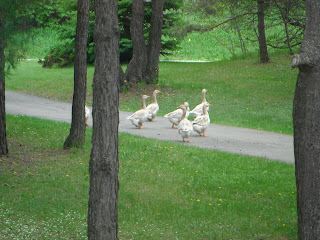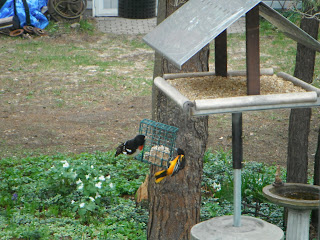
I grew up in the city of Toronto and moved to a small town (population 1,200) in the mid 80s. I raised my children there and later, moved with them to a slightly larger town. When they left the roost, so to speak, me and my partner headed to the country. Real rural, that is. A bit of property (about four acres). Neighbours far enough away you could walk around naked, if you wanted to (I don't want to).
But I could.
There was a time in my life when I would gently mock the 'hillbilly country folk.' I guess what I saw on TV perpetuated the hillbilly mentality and I totally bought into it.
Shame on me. They're not like that at all. I can say that because now, I am a total hillbilly.
When I say 'hillbilly,' I don't mean it in the TV sense. I mean 'hillbilly' as someone who loves nature as much as they love people; someone who appreciates the smell of the woodstove burning smoke out the chimney; someone who stops to not only feed the birds on a daily basis, but someone who stops to hear the birds singing, whistling and chirping all day and into the early evening.
My 'hillbilly' is someone who has their eggs delivered to the door by the local egg man ($5 for 2 1/2 dozen) and who calls their neighbour to help re-locate a pesky racoon.
Yeah, but my hillbilly would certainly lose if there was ever a 'best dressed outdoors' look. My outdoors look is definitely old-style hillbilly where nothing is colour-coded or even matches, and there are rubber boots that come to the knees as well as a Fargo-inspired furry cap that's a necessity in the winter.
And when the weather turns bad, we have it real bad here. And I guess that also contributes to a 'hillbilly' outlook. We just go with it. So.... power's out for four days? Crank the wood stove.
Snow's one metre deep on the roof? Shovel some off.
Snow's two metres deep on the driveway? Crank up that snow blower.
Winter thaw brings a flood? Bring out the canoe.
Trees are dying or branches breaking? Fire up the chainsaw.
A million stars shine brightly at night and the gossamer waves of the Northern Lights appear in the sky? Pour a giant Caesar, pick an outdoor chair and gaze at the sky.
It that makes us better hillbillies, then I guess we're doing allllright.
 |
| A wee, temporary flood in the back... bring out the canoe! |
 |
| Feeding birds in your pjs? Yup, hillbilly style, right in the hand. |
 |
| Beautiful, gentle deer all winter long. |
 |
| Me, not in a fashion show. |
 |
These are two bush cords of wood I stacked -
we use four bush cords per winter for our wood stove :)
|
 |
Relaxing in overalls by the firepit after a day of cutting wood.
|
 |
| Bald eagle nest and bald eagle guard, near our home. |
 |
| Our neighbour's Guinea hens come to pick around our bird feeder, almost daily. |
 |
| Our neighbour's geese also come visiting. |
 |
| Birds to our bird feeder include Grosbeaks and Baltimore Orioles. |
 |
| Cardinals are here year-round. |
 |
| Cheeky blue Jays also here year-round. |
Enjoy nature today - it's as beautiful as you are.
J.C. Kavanagh
The Twisted Climb - Darkness Descends
(Book 2)
voted BEST Young Adult Book 2018,
Critters Readers Poll
AND
The Twisted Climb,
voted BEST Young Adult Book 2016,
P&E Readers Poll
Novels for teens, young adults and
adults young at heart
Email: author.j.c.kavanagh@gmail.com
www.facebook.com/J.C.Kavanagh
www.amazon.com/author/jckavanagh
Twitter @JCKavanagh1 (Author J.C.
Kavanagh)



















